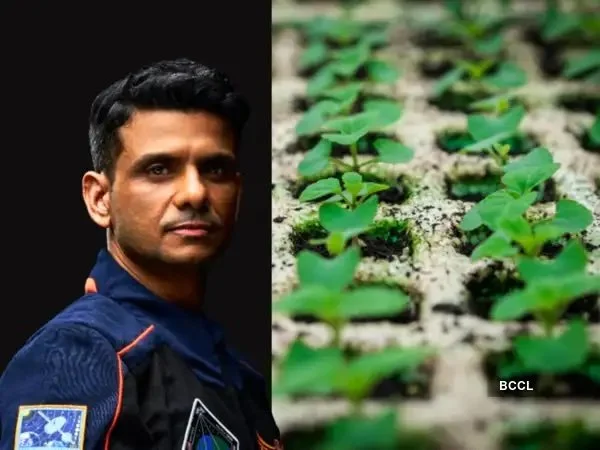Exploring 10 studies carried out by Axiom-4
On June 25, the Ax-4 private mission brought citizens from India, Poland, and Hungary to space on journey to the International Space Station (ISS). The crew of four represented four countries: Shubhanshu Shukla from India, Sławosz Uznański-Wiśniewski from Poland, Tibor Kapu from Hungary, and Peggy Whitson, the mission commander, from the United States. The group executed scientific studies and activities sponsored by 31 countries including the U.S., India, Poland, Hungary, Saudi Arabia, Brazil, Nigeria, UAE, and nations across Europe.
Credit: Axiom Space
This mission included 60 studies, some new and many similar to other studies performed in previous space flights and sponsored by different countries and companies. This article will focus on a few of them, offering insights into the future of accessible and sustainable space exploration.
Falling under the category of similar studies is the study sponsored by Burjeel Holdings PLC. This UAE-based healthcare services provider looks to demonstrate the accuracy of Continuous Glucose Monitors (CGMs) for diabetic space travelers. This study highlights the attention space flight draws from institutes and businesses worldwide. As more companies look to provide the necessary tools and services to make space accessible to all kinds of people, we are also opening new economic growth opportunities here on Earth.
One other physiological experiment that relates to studies run in previous space missions is the ISS Edge Computing for Crew Readiness Demonstration by Booz Allen, Axiom Space, and Oura. This study could benefit multiple industries on Earth that rely heavily on skilled human performance. In space, this technology demonstration aims to assess the preparedness of astronauts and future space travelers to execute critical tasks. The goal is to eventually eliminate the need for continuous communication with Earth to complete critical tasks and activities during spaceflight.
Among the experiments brought from the home country of one of the crew members and sponsored by the Indian Institute of Space Science and Technology is “Sprouts”. This study looks to assess the impact of spaceflight on six varieties of crop seeds, germination, and growth in space, and understand how crops may be grown in space for future exploration missions.
Another study sponsored by the International Centre for Genetic Engineering and Biotechnology (ICGEB) in India looks to study the growth rates, cellular responses, and biochemical activity in microgravity of cyanobacteria, which, through the photosynthetic process, produce oxygen and could be integrated into spacecraft environmental control systems.
Credit: Axiom Space
Two independent studies, one sponsored by ICGEB and the other by the Polish Space Agency (POLSA) and ESA, have algae taking the stage as potential producers of oxygen, for waste management, toxic compound decomposition, and viability as a sustainable food and life-support system for astronauts. Each study used different types of algae. ICGEB studies three edible micro algae, while POLSA/ESA focuses on a sturdy volcanic red variant found to grow in extreme environments. The results gathered in this mission might help develop future sustainable systems for living in space and enable survival under extreme terrestrial conditions.
Another interesting experiment investigates the revival, survival, and reproduction of tardigrades. These minuscule anthropoids, known also as water bears and described as the toughest animals on Earth, have been in space studies since 2007. In this study, the Indian Institute of Science looks to identify molecular mechanisms of resilience, which have implications for understanding the limits of life in extreme environments, like space and here on Earth. In this mission, ESA also conducted a related study using a tardigrade gene. This experiment tests yeast genetically modified with the tardigrade gene into its genome. Tests on Earth have linked this gene to the resistance of tardigrade yeast to extreme environmental conditions. The results of these tests are essential in defining the feasibility of using such modified yeast in biofactories on Mars, the Moon, or during space travel.
Credit: Grok
In partnership with Polish KP Labs, ESA conducted the Leopard ISS test, focused on data processing for space applications. The activity included the installation of the Leopard Data Processing Unit (DPU), a compact PC-104 designed for micro and mini Satellites, on the Columbus module of the ISS, looking to test AI algorithms directly in space. Leopard will be part of the digital system in the ISS that researchers and institutions can use to upload, test, and validate algorithms in real space conditions without requiring them to buy their hardware.
Another interesting project sponsored by POLSA/ESA is testing the effects of cosmic radiation on drug stability. The experiment includes sample packages that will be stored in the ISS under different conditions for 1, 2, and 3 years. After return, samples will be analyzed and compared to ground control samples to assess their space-based shelf-life.
To learn about the full scientific studies and activities performed during this mission, visit the Axiom-4 website.
References:
https://researchinestonia.eu/2025/07/21/international-space-station/
https://issnationallab.org/press-releases/ax4-booz-allen-sleep-tech/
https://www.esa.int/ESA_Multimedia/Images/2025/07/Space_volcanic_algae_in_space
https://www.kplabs.space/projects-and-missions/leopardiss---ignis-mission



